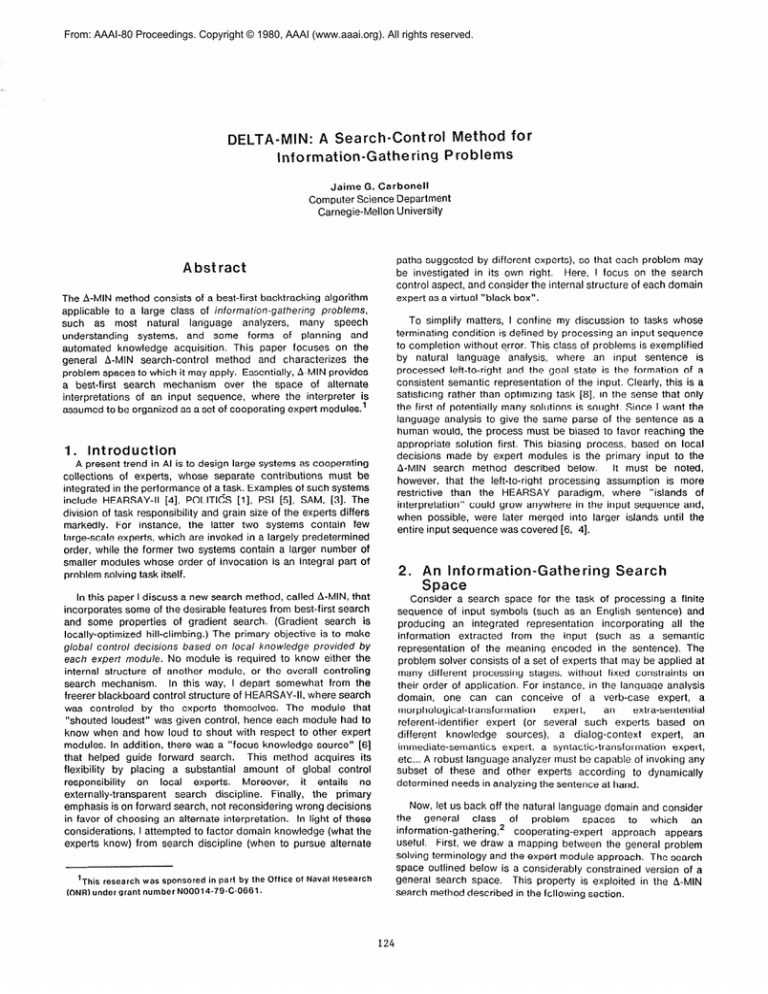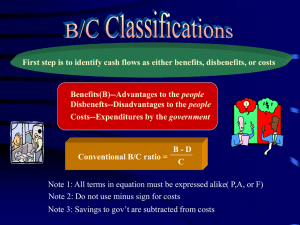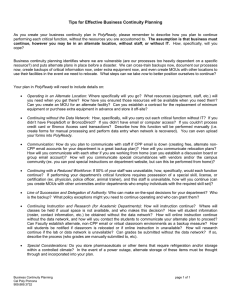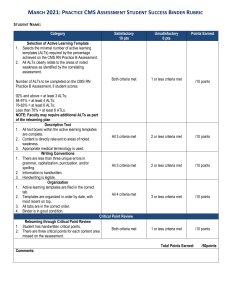
From: AAAI-80 Proceedings. Copyright © 1980, AAAI (www.aaai.org). All rights reserved.
DELTA-MIN:
A Search-Control
Information-Gathering
Method for
Problems
Jaime G. Carbonell
Computer Science Department
Carnegie-Mellon University
paths suggested by different experts), so that each problem may
be investigated in its own right.
Here, I focus on the search
control aspect, and consider the internal structure of each domain
expert as a virtual “black box”.
Abstract
The A-MIN method consists of a best-first backtracking algorithm
applicable to a large class of information-gathering
problems,
such as most natural
language
analyzers,
many speech
understanding
systems, and some forms of planning
and
automated knowledge acquisition.
This paper focuses on the
general A-MIN search-control
method and characterizes
the
problem spaces to which it may apply. Essentially, A-MIN provides
a best-first search mechanism
over the space of alternate
interpretations
of an input sequence, where the interpreter is
assumed to be organized as a set of cooperating expert modules.’
1.
To simplify matters, I confine my discussion to tasks whose
terminating condition is defined by processing an input sequence
to completion without error. This class of problems is exemplified
by natural language
analysis, where an input sentence
is
processed left-to-right and the goal state is the formation of a
consistent semantic representation of the input. Clearly, this is a
satisficing rather than optimizing task [8], in the sense that only
the first of potentially many solutions is sought. Since I want the
language analysis to give the same parse of the sentence as a
human would, the process must be biased to favor reaching the
appropriate solution first. This biasing process, based on local
decisions made by expert modules is the primary input to the
A-MIN search method described
below.
It must be noted,
however, that the left-to-right
processing assumption is more
restrictive
than the HEARSAY paradigm,
where “islands of
interpretation” could grow anywhere in the input sequence and,
when possible, were later merged into larger islands until the
entire input sequence was covered [6, 41.
Introduction
A present trend in Al is to design large systems as cooperating
collections of experts, whose separate contributions
must be
integrated in the performance of a task. Examples of such systems
include HEARSAY-II [4], POLITICS [l], PSI [5], SAM, [3]. The
division of task responsibility and grain size of the experts differs
markedly. For instance, the latter two systems contain few
large-scale experts, which are invoked in a largely predetermined
order, while the former two systems contain a larger number of
smaller modules whose order of invocation is an integral part of
problem solving task itself.
2.
In this paper I discuss a new search method, called A-MIN, that
incorporates some of the desirable features from best-first search
and some properties of gradient search. (Gradient search is
locally-optimized
hill-climbing.) The primary objective is to make
global control
decisions
based on local knowledge
provided
No module is required to know either
each expert
module.
1
This
research
under
grant
was
sponsored
number
NO001
in part
by the Office
of Naval
Search
Consider a search space for the task of processing a finite
sequence of input symbols (such as an English sentence) and
producing
an integrated
representation
incorporating
all the
information
extracted
from the input (such as a semantic
representation
of the meaning encoded in the sentence). The
problem solver consists of a set of experts that may be applied at
many different processing stages, without fixed constraints on
their order of application. For instance, in the language analysis
a
domain,
one can can conceive
of a verb-case
expert,
morphological-transformation
expert,
an
extra-sentential
referent-identifier
expert (or several such experts based on
different
knowledge
sources),
a dialog-context
expert,
an
immediate-semantics
expert, a syntactic-transformation
expert,
etc... A robust language analyzer must be capable of invoking any
subset Of these and other experts according
to dynamically
determined needs in analyzing the sentence at hand.
by
the
internal structure of another module, or the overall controling
In this way, I depart somewhat from the
search mechanism.
freerer blackboard control structure of HEARSAY-II, where search
was controled
by the experts themselves.
The module that
“shouted loudest” was given control, hence each module had to
know when and how loud to shout with respect to other expert
modules. In addition, there was a “focus knowledge source” [6]
that helped guide forward search.
This method acquires its
flexibility
by placing a substantial
amount of global control
responsibility
on local
experts.
Moreover,
it entails
no
externally-transparent
search discipline.
Finally, the primary
emphasis is on forward search, not reconsidering wrong decisions
in favor of choosing an alternate interpretation.
In light of these
considerations, I attempted to factor domain knowledge (what the
experts know) from search discipline (when to pursue alternate
(ONR)
An Information-Gathering
Space
NOW, let US back off the natural language domain and consider
the
general
class
of
problem
spaces
to
which
an
information-gathering,*
cooperating-expert
approach
appears
useful. First, we draw a mapping between the general problem
solving terminOlOgy
and the expert module approach. The search
space outlined below is a considerably constrained version of a
general search space.
This property is exploited in the A-MIN
search method described in the fcllowing Section.
Research
4-79-C-0661.
124
e The operators in the search space are the individual
expert modules.
Each module may search its own
space internally, but I am concerned only with the
macro-structure
search space.
Each expert has
conditions
of strict applicability
and preference of
applicability. The latter are used for conflict resolution
decisions when more than one expert is applicable.
Search
o A state in the space consists of the total knowledge
gathered by invoking the set of experts that caused
the state transitions
from the initial state to ihe
This definition
has two
significant
present.
implications: An expert that adds no new knowledge
when invoked does not generate
a new state;
therefore, it can be ignored by the search control.
There is a monotonicity
property in that each step
away from the initial states adds information to the
analysis, and therefore is guaranteed to “climb” to a
potential final state. (Left-to-right, single-pass natural
language
analysis
can exhibit
such
monotonic
behavior.)
for
assigning
a
responsible
is
expert
Every
likelihood-of-correctness
value
to each
alternative
in the
interpretation it outputs. These values are only used to determine
how much better the best alternative
is than the next best
alternatives, an item of information crucial to the backtrack control
mechanism. There is no global evaluation function (the outputs of
different experts are not directly comparable - it makes no sense
to ask questions like: “Is this anaphoric referent specification
better than that syntactic segmentation?“)
Nor is there any
mechanism to compute differences between the present state and
the goal state. (Recall our definition of goal state -- only upon
completion
of the input processing
can the goal state be
established.)
e A final state is defined by having reached the end of
the input sequence without violating a path constraint,
and no expert can add more information
(i.e., no
transition in the state space is possible).
PROCEDURE
A-MIN(initial-state.
experts)
altlist
:= NULL
globaldelta
:= 0
state
:= initial-state
input := READ(firsfinput)
NEXTOP:
IF NULL(input)
THEN RETURN(state)
ELSE operator
:= SELECTBEST(APPLICABLE(experts))
IF NULL(operator)
THEN input := READ( next input)
ALSO GO NEXTOP
ELSE alts := APPLY(operator,
state)
IF NULL(alts)
THEN MARK(operator.
'NOT-APPLICABLE,
'TEMP)
ALSO GO NEXTOP
bestalt
:= SELECTMAX(alts)
IF Ilaltsll
> 1
alts)
THEN alts := FOR-EACH
alt IN REMOVE(bestalt,
COLLECT
<'ALT:
alt,
'STATE: state,
'DELTA: globaldelta
+ VALUE(bestalt)
- VALUE(alt)>
altlist
:= APPEND(alts,
altlist)
NEWSTATE:
state
:= MERGE-INFORMATION(state,
bestalt)
IF NOT(state
= 'ERROR')
GO NEXTOP
; if no error, continue
gradient
search,
; else delta-min
backup below
WHILE state
has no viable alternatives
DO BEGIN
MARK(state,
'DEAD-END,
'PERM)
; delete dead ends
; from search tree
state
:= PARENT(state)
END
backup-point
:= SELECTDELTA-MIN(altlist)
state
:= GET(backup-point.
'STATE:)
globaldelta
:= GET(backup-point,
'DELTA:)
bestalt
:= GET(backup-point,
'ALT:)
altlist
:= REMOVE(backup-point.
altlist)
GO NEWSTATE
END A-MIN
e A path constraint is violated if either a new segment of
the input cannot be incorporated or an expert asserts
information that contradicts that which is already part
of the current state.
When this situation arises,
directed backtracking becomes necessary.
o The initial state is a (possibly
that must be satisfied by any
sequence. For instance, a
constrains the interpretation
natural language tasks.
empty) set of constraints
interpretation of the input
dialog or story context
of an utterance in many
o Each expert can draw more than one conclusion
when
applied.
Choosing
the
appropriate
and minimizing
backtracking
on
conclusion
alternatives
is where the real search problem
lies. Choosing the next expert to apply is not a real
problem,
as the
final
interpretation
is often
independent of the order of application of experts.
That is, since information-gathering
is in principle
additive, different application sequences of the same
experts should converge to the same final state. The
experts
preselect
themselves
as to applicability.
Selecting the expert who thinks it can add the most
information (as in HEARSAY-II) only tends to shorten
the path to the final state. The real search lies in
considering
alternate
interpretations
of the input,
which
can
only
be resolved
by establishing
consistency with later information gathered by other
experts.
Finally, given the possibility
of focused
backtracking fro& a dead end in the forward search,
less effort needs to be directed at finding the “one
and only correct expert” to apply.
2 "lnformetion
search
problems
accruing
gathering"
where
is a term
progress
coined
towards
and integrating information from
by
Rai Reddy
Figure
3-1:
The A-MIN Search-Control
Algorithm
Let us see how A-MIN can be applied to an abstract example,
following the diagram in figure 3-Z The roman numerals in the
arcs reflect the order in which they are traversed.
At the initial
state,
expert-4
applies
and
generates
three
alternate
interpretations
of the input. One alternative is ranked as most
likely. A “A” value is computed for the remaining alternatives,
encoding the difference in confidence that expert-4 had between
them and the most likely alternative. The more sure expert-4 is of
its best choice relative to the other alternatives, the larger the A
to refer to
agoalstateischaracterized
Metho
A-MIN is a heuristic search method specifically tailored to the
class of search spaces described above. It combines some of the
more desirable features of gradient search and best-first search,
with the modularized information sources of a cooperating-expert
paradigm.
Figure 3-O is the search-control
strategy algorithm in
an MLISP-style form. Subsequently I discuss how A-MIN works,
exemplifying the discussion with a sample search-tree diagram.
by
outside SOUrCeS.
125
Therefore, one
more reasonable to doubt expert-5’s decision.
wants to back up to the point where the probability of having
chosen a wrong branch is highest, namely to the choice point with
the minimal A (hence the name A-MIN).
values. The best interpretation generated by expert-4 is integrated
with the initial state constraints and found to be consistent. At this
point, a new state has been generated and expert-2 applies to this
More input is read and
state generating no new information.
expert-l applies, generating only one alternative, which is found to
be consistent with the information in the present state. In a similar
fashion, the rest of the tree in figure 3-xis generated.
Continuing with figure 3-z we restore the state at expert-5 and
incorporate the A = 2 interpretation.
It is found to be consistent,
and we apply expert-l to the new state. The best interpretation of
expert-l leads to error, and backup is again required. Where to
now? The minimal A is at expert-l, but this would mean choosing
a non-optimal
branch
of a non-optimal
branch.
Lack of
confidence in the choice from expert-5 should be propagated to
the present invocation of expert-l.
Hence, we add the two As in
the path from the inital state and get the value: A =3, which is
greater than the minimal A at expert-4 (A = 2). Therefore, we
back up to expert-4.
This process continues until a consistent
interpretation
of the entire input is found (i.e., a goal state is
exhausts
all
viable
alternate
reached),
or the
search
intepretations.
Up to now, we have witnessed an instance of gradient search,
where a different evaluation function is applied at each node (The
local evaluation function is, in effect, the expert who generated the
likelihood values.) If no error occurs, (i.e., if the interpretation of
the input remains consistent) no backup is needed. The likelihood
rankings clearly minimize the chance of error as compared to
straightforward
depth first search.
Now, let us consider the
possibility of an inconsistency in the interpretation, as we continue
to examine figure 3-X
Essentially,
A-MIN is a method for finding
one globally
consistent interpretation
of an input sequence processed in a
predetermined order. In natural language analysis, the problem is
to find a semantically, syntactically,
and contextually
consistent
parse of a sentence. In speech understanding
the constraint of
formulating legal phonemes and words is added, but the nature of
the problem and the applicability of the A-MIN approach remains
the same. For instance, A-MIN is an alternate control structure to
HARPY’s beam search [7], which also processes a sequence of
symbols left to right, seeking a globally consistent interpretation.
4.
Concluding
To summarize,
properties:
Remarks
the
A-MIN
method
exhibits
the
following
o A-MIN is equivalent to gradient search while no error
Path length (from the initial state) is not a
occurs.
factor in the decision function.
o The backtracking mechanism is directed to undo the
choice most likely to have caused an interpretation
error. This method compares all active nodes in the
tree, as in best-first search, but only when an error
occurs (unlike best-first search).
o Perseverance in one search path is rewarded, as long
as the interpretation
remains
consistent,
while
compounding
less-than-optimal
alternate choices is
penalized. This behavior falls out of the way in which
A values are accrued.
Figure
3-2:
o No
global
evaluation
function
forces
direct
comparisons among information gathered by different
knowledge sources.
Such an evaluation
function
would necessarily
need to encode much of the
information contained in the separate experts, thus
defeating
the
purpose
of
a
modular
cooperating-expert
approach.
The A comparisons
contrast only the differences between locally-optimal
and locally-suboptimal
decisions. These differences
are computed by local experts, but the comparisons
themselves are only between relative ratings on the
desirability of alternate decisions.
A-MIN Search Tree With Directed Backup
The most likely interpretation generated by expert-6 was found
in the present state.
with the information
to be inconsistent
Backup is therefore necessary, given the depth-first nature of the
But, where do we back up to? Normally, one might
search.
consider a depth-first unwinding of the search tree; but, is this the
most reasonable strategy? Expert-5 was much less certain in its
choice of best alternative than expert-6 (A = 2 vs A = 4). It seems
126
Additional discussion of implementation, analysis, and details of
the A-MIN search method may be found in [2], where an effective
application of A-MIN is discussed for constraining
search in a
natural language processing task.
References
1.
Carbonell, J. G., “POLITICS: An Experiment in Subjective
Understanding
and Integrated
Reasoning,”
in inside
Computer
Understanding:
R. C. Schank and
Erlbaum, 1980.
Five Programs
C. K.
Riesbeck,
Plus Miniatures,
eds.,
New
Jersey:
2.
Carbonell, J. G., “Search in a Non-Homogeneous
Problem
Space - The A-MIN Algorithm,” Tech. report, Dept. of
Computer Science, Carnegie-Mellon University, 1980.
3.
Cullingford,
Understanding
R.,
Script
of, Newspaper
Application:
Stories,
Computer
PhD dissertation,
Yale University, Sept. 1977.
4.
Erman L. D. and Lesser, V. R., “HEARSAY-II:
Tutorial
Introduction & Retrospective View,” Tech. report, Dept. of
Computer Science, Carnegie-Mellon University, May 1978.
5.
Green, C. C., “The Design of the PSI Program Synthesis
of
the
Second
International
System, ” Proceedings
Conference
on Software
Engineering,
October 1976 , pp.
4-18.
6.
Hayes-Roth, F. and Lesser, V. R., “Focus of Attention in the
Hearsay-II Speech Understanding System,” Proceedings
of
the
Fifth
Intelligence,
7.
8.
international
Joint
Conference
on
Artificial
1977 , pp.. 27-35.
Lowerre, B., “The HARPY Speech Recognition System,”
Department,
report Computer
Tech.
Science
Carnegie-Mellon University, April 1976.
Newell, A. and Simon, H. A., Human
Prentice-Hall, 1972.
Problem
Solving,
New
Jersey:
127




